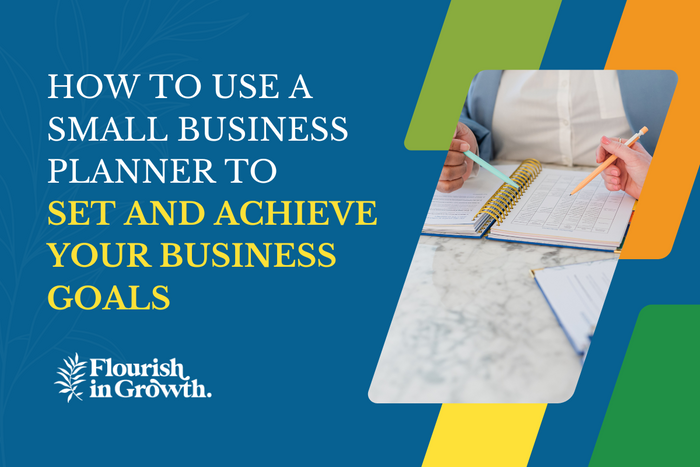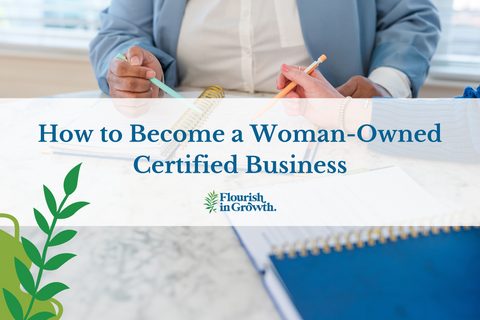How to Use a Small Business Planner to Set and Achieve Your Business Goals

What is planning? When I think of planning, I think of hoped-for outcomes and taking a moment to decide what I want to happen and how I’m going to make it happen. It’s about being intentional.
Merriam-Webster defines “to plan” as “a method for achieving an end,” and that feels spot on. Planning is less about perfection and more about having a sense of direction. It’s about choosing your next steps with purpose.
Why Planning Is Essential for Small Business Owners
One of the biggest benefits of planning is that it helps you act based on your overall vision. Which in turn allows you to prioritize each month, week, and day. I love making decisions that line up with my values and the future I’m working toward!
I find that planning also takes a lot of the pressure off and almost automates some parts of my day. Because I’m mapping things out in advance, there’s also a lower mental load for my daily work, a huge win! Sure, it won’t take away every mistake or unknown, but it makes the process of building and running a business a whole lot easier.
When most people think of planners, they think of a calendar and a goal or project tracker—something that may include a to-do list, appointments, and a daily or weekly plan. Those tools are great for projects and daily planning, but I have found that the challenge often lies in not knowing what tasks to write down and why they matter for your long-term business goals. When I talk about planning in this post, I’m talking about setting a big picture for what you hope to accomplish long-term and breaking it down into smaller steps that can then be put into a simple list.
Think about it like this, The Guided Small Business Planner provides specific guidance for creating that big-picture plan for your business, while a calendar or generic project planner is about the exact activities you will do that day or week Since I love a good metaphor, let’s say you were building a house, you’d start with a list of features that you want to incorporate, then you’d work with an architect to create a blueprint of the space. The blueprint is then given to a builder to build the house. Of course, you’ll make changes along the way, but you wouldn’t go buy lumber and start building a house without a blueprint! The Guided Small Business Planner helps create your business blueprint so that you can build your business based on your vision. I’ll dive more into what makes a business planner a strong tool, but first, let’s talk about the benefits of using a paper product rather than a digital one.
Why Use a Physical Planner Instead of a Digital One?
I use a lot of digital tools in my work, and I love a good spreadsheet, but there’s something different about physically writing things down. Studies have shown that the physical act of writing leads to better understanding, comprehension, and memory. It helps your brain connect the dots in a different way. I’ve seen this firsthand from taking notes during a meeting versus typing them. I’ve also found that when I draw out a concept that is new or challenging, I remember it much more than typing a few bullet points.
I’ve linked a few sources about this at the bottom of the post if you want to dive into the science behind writing versus typing!
How a Physical Small Business Planner Supports Focus
Technology is distracting! Using a physical planner slows you down in a good way. It makes space for reflection. It helps retain focus, and it activates a larger portion of the brain as we process information! I find that I’m able to problem-solve more creatively and think outside of the box when I’m focused.
What Type of Small Business Planner Is Right for You?
Not all planners are created equal, and not every type works for every business owner. Here are a few common ones to think about:
Daily or Calendar Planners
Great for managing appointments, to-dos, and daily structure. These help with time blocking and task tracking. I use a digital calendar for appointments and a time-blocking daily planner for my to-dos.
Goal and Project Planners
Designed to help you break big goals into small steps, these are great when you have a specific outcome in mind, like launching a new product or hitting a revenue target. I love the Cultivate What Matters products for this!
Business Planners
There are two types of business planners. A generic one is structured like a day planner or calendar with space for you to name what you are going to do that week or day. I like these for being intentional about how my day or week is structured! A guided business planner is different because it’s intended to help you name and clarify your long-term and big-picture business goals. If you find yourself asking how to define your big picture and long-term goals, a guided, step-by-step planner can help you get the point of naming your daily task list.
How to Start Using a Small Business Planner
There’s no one “right way” to use a planner. But there is a right way for you. Start by asking: What kind of support do I need?
Start With the Big Picture
If you’re looking for big-picture clarity and intentional growth, something like The Guided Small Business Planner might be your best fit. It gives you space to define your business strategy, name your customers, and build a marketing plan, calculate revenue streams, and thoughtfully plan your brand presence. Then it provides real-life examples and templates for you to decide how it will come to life for your business.
Get Specific With Daily Tasks
Once you have named your big picture, you may want to add a daily or project planner. They can be helpful if you’re juggling tasks, appointments, and responsibilities. A daily or calendar-style planner will help you manage your time and stay on track.
I use both! The Guided Small Business Planner has my marketing plan, ideal customer persona, my sales goals, my income goals, my operations, and my vision and mission. My calendar includes time blocking and my daily, weekly, and monthly to-dos.
Comparing Popular Small Business Planner Options
Here’s a quick breakdown of how different types of planners stack up.
Start Planning With Purpose
As you build your business, remember that it’s okay to pause and change your mind!
I designed The Guided Small Business Planner to be your quiet space to reflect, plan, build, reset, and decide what matters most, and then take real steps to make it happen.
We'd love to hear: Do you have a favorite tool for planning?
Are you inspired to pick one up? Please share in the comments!
You May Also Enjoy
- How Can You Start A Business Without Money? Tips for Beginners
- How to Start a Business from Scratch
- How to Become a Woman-Owned Certified Business
About Flourish In Growth
We help business owners navigate the ups and downs of building the business they want. Our rules are: Clear, simple, no-fluff, and actionable! Stop doubting yourself. Meet your small business map—The Guided Small Business Planner™. This is a workbook guide with step-by-step instructions for building a strong business foundation. It's not a calendar. It's a guided workbook.
Sources:








